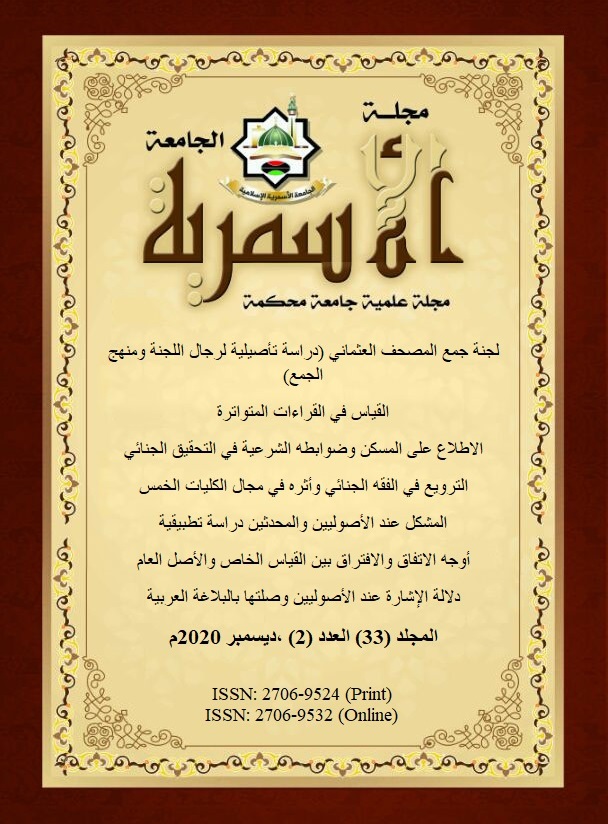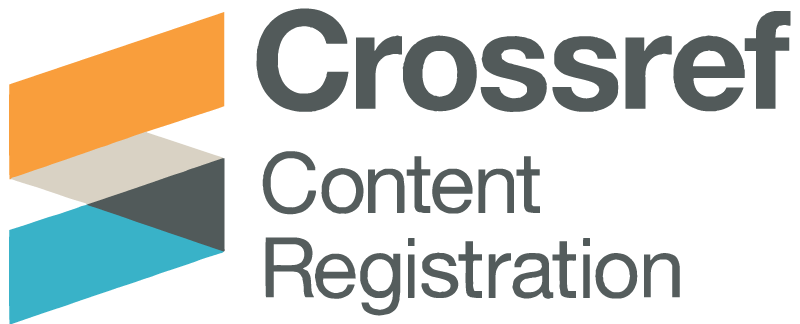A Functional Analysis of Teacher Talk in English as a Foreign Language (EFL) classroom at Al-Asmariya University
A Case Study of Classroom Discourse within the Perspective of Systemic Functional Grammar (SFG) Notion
DOI:
https://doi.org/10.59743/jau.v33i2.1334Keywords:
Teachers talk, interpersonal meaning, SFGAbstract
This study is conducted to concentrate on the analysis of classroom discourse, specifically, teaches talk in the EFL classroom at Al-Asmariya Islamic University, Zliten. It attempts to realize the interpersonal meaning built in the male and female teachers' interaction in the classroom, and the difference between the male and female roles based on the interactional MOOD ANALYSIS of Systemic Functional Grammar model which is presented by Halliday (1985, 1994, 2004 & 2014). In this study, discourse analysis and descriptive-qualitative textual analysis are applied as research methods. The data were collected through the method of observations by recording the conversation between the teachers and the students during the lectures. Questionnaire is used in the study to collect more data and support analysis. The utterances of the spoken language collected were analysed within the concept of SFG. The analysis was performed on the Mood structure of the clause in order to realize the interpersonal meaning constructed in the interaction. (Bloor and Bloor, 2013) clarifythat Functional Grammar is the study of how meanings are built up through the choices of words and other grammatical structures. The study resulted in that the speech functions had been used differently by the male and female teachers to create the interpersonal metafunction in their interaction with the students. The female teacher tended to apply interrogative clauses of Mood dominantly while the male teacher used declarative clauses mostly. Therefore, they play different roles in the teaching process.
References
Alaei, H. (2010). Comparative study of the importance of managerial and leadership behaviors from the perspective of teachers and principals (Unpublished master‟s thesis). Department of Educational Sciences, Faculty of Educational Sciences and Psychology, University of Sistan and Baluchestan, Iran.
Alwasilah, C. A. 2002. The basics of designing and conducting qualitative research. Bandung: Pustaka Jaya.
Bloor, T., & Bloor, M. (2013). The Functional Analysis of English: A Hallidyan Approach. (Third Edition). New York: Routledge. Cazden, C. (1988). Classroom Discourse. The Language of Teaching and Learning. Porthmouth, NH Heinemann. DOI: https://doi.org/10.4324/9780203538098
Christie, F. (2005). Language Education in the Primary years. Sydney: University of New South Wales Press.
Eggins, S. (1994). An Introduction to Systemic Functional Linguistics. London/New, York: Pinter Publishers.
Eggins, S. (2000). Researching Everyday Talk in Research Language in Schools and Communities: Functional Linguistic Perspectives.
Eggins, S. (2004). An Introduction to Systemic Functional Linguistics (Second Edition.).London/ New York: Continuum International Publishing Group.
Eggins, S. and Slade. D. (2005). Analysing Casual Conversation. Equinox Publishing Ltd.
Fikri, Z., Dewi, Ni., & Suarnajaya, W. (2014). Mood Structure Analysis of Teacher Talk in EFL Classroom: A Discourse Study Based on Systemic Functional Linguistic Theory. e-Journal Program Pascasarjana Universitas Pendidikan Ganesha, 2.
Fishman, P. M. (1978a). Interaction: The work women do. Social Problems, 25, 397–406. Fontain, L. (2013) Analyzing English Grammar: A systemic- Functional Introduction. Cambridge: Cambridge University Press. DOI: https://doi.org/10.1525/sp.1978.25.4.03a00050
Gee. J. P. (1999). An introduction to Discourse Analysis Theory and Method. (1st Edition). Routledge. New York.
Goffman. L. (2004). Kinematic Differentiation of Prosodic Categories in Normal and Disordered Language Developmet. Journal of Speech Language and Hearing Research 47(5):1088-102. University of Texas. DOI: https://doi.org/10.1044/1092-4388(2004/081)
Halliday, M.A.K. (1985). An Introduction to Functional Grammar. London: Edward. Arnold.
Halliday, M. A. K., & Matthiessen, C. M. I. M. (1994). An Introduction to Functional Grammar (Second Edition). London: Edward Arnold.
Halliday, M. A. K. & Matthiessen, C. (2004). An Introduction to Functional Grammar. (Third Edition). London: Hodder Arnold.
Halliday, M.A.K. & Matthiessen, C. (2014). Halliday‟s Introduction to Functional Grammar (Fourth Edition). New York: Routledge. DOI: https://doi.org/10.4324/9780203783771
Harmer, J. 2001. The Practice of English Language Teaching. 3rd Edition. Longman. Conversation. London: Casell.
Harmer, J. 2007. The Practice of English Language Teaching: Fourth Edition”. China: Pearson Education Limited. Hayes, R. L., & Lin, H. (1994). Coming to America: Developing social upport systems for international students. Journal of Multicultural Counseling and Development, 22, 7–16. DOI: https://doi.org/10.1002/j.2161-1912.1994.tb00238.x
Henry, F. and Tator, C. (2002). Discourses of Domination: Racial Bias in the Canadian English-Language Press. University of Toronto, 2002. DOI: https://doi.org/10.3138/9781442673946
Holmes, Janet, 2001. Learning about language. An Introduction to Sociolinguistics. London: Pearson Education Limited. 2nd Edition.
Martin, J. R. (1992). English Text: System and Structure. Amsterdam: John Benjamins. DOI: https://doi.org/10.1075/z.59
MacMillan, J.H. and Schumacher, S. (2001) Research in Education. A Conceptual Introduction. 5th Edition, Longman, Boston.
Merriam, B. S. 1998. Qualitative Research and Case Study Applications in Educations: Revised and Expanded from Case Study Research in Education. San Fransisco: Jossey Bass Publisher.
Mulac, A. (1999). Perceptions of Women and Men Based on Their Linguistic Behavior: The Gender Linked Effect. In Pasero, Ursula, Braun, Friederike (ed), Percieving and Performing Gender. Opladen/ Wiesbaden: Westdeuscher Velag. 88-104. DOI: https://doi.org/10.1007/978-3-322-89014-6_7
Nunan, D. (1993). Introducing Discourse Analysis. London: Penguin., p.2.
Otten, S. (2010). Discourse Analysis and Functional Grammar in the Classroom: The summary of a mini-reading course. Research Paper, Michigan State University.
Paltridge. B. (2012) Discourse Analysis: An Introduction (Second Edition). London: Bloomsbury Academic. 2012. Pp. VI, 282. DOI: https://doi.org/10.5040/9781350934290
Silverman, D. 2005. Doing Qualitative Research, a Practical Handbook. New Delhi: Sage Publication.
Shitemi, N. L. 2009. Language and Gender. A Lecture to be given to IUPUI Fulbright-hays group projects abroad program, July 5th - August 6th 2009 At Moi University Campuses.
Suherdi, D. (2010). Classroom Discourse Analysis: A Systemiotic Approach. (3rd Ed). Bandung: CELTICS Press.
Van Dijk, T. (1998). Critical Discourse analysis. In D. Tannen, D. Schifrin & H. Hamilton (eds.). Handbook of Discourse Analysis.
Xiao-yan. (2006). Teacher Talk and EFL in University Classroom. China, 2006. Print
Downloads
Published
How to Cite
Issue
Section
License
Copyright (c) 2020 فاطمة محمد محمد فرحات

This work is licensed under a Creative Commons Attribution 4.0 International License.
The rights relate to the publication and distribution of research published in the Journal of Alasmarya University where authors who have published their articles in the Journal of Alasmarya University should Know how they can use or distribute their articles. They reserve all their rights to the published works, such as (but not limited to) the following rights:
- Copyright and other property rights related to the article, such as patent rights.
- Copyright on all open access article in Journal of Alasmarya published by Alasmarya Islamic University is retained by the author(s) and they can used in it's future works, including lectures and books, the right to reproduce articles for their own purposes, and the right to self-archive their articles..
- Authors grant Alasmarya Islamic University a license to publish the article and identify itself as the original publisher.
- Authors also grant any third party the right to use the article freely as long as its integrity is maintained and its original authors, citation details and publisher are identified.
The Creative Commons Attribution License 4.0 formalizes these and other terms and conditions of publishing articles










